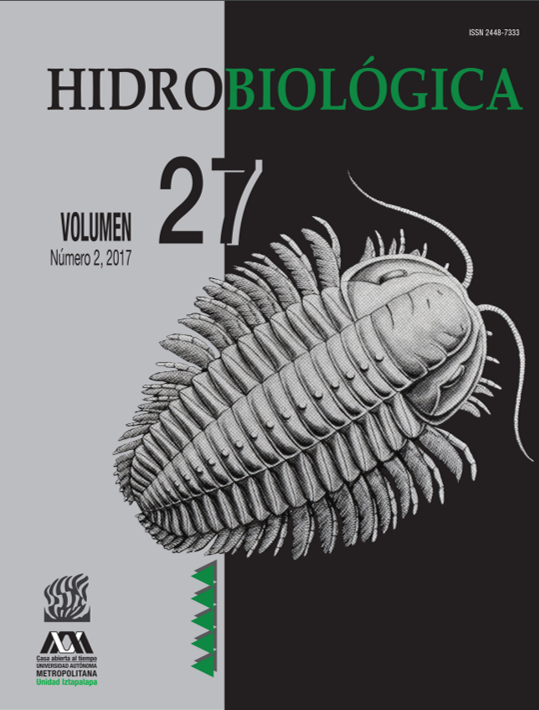Acute salinity tolerance of native and introduced freshwater gastropods of Tabasco, Mexico
DOI:
https://doi.org/10.24275/uam/izt/dcbs/hidro/2017v27n2/RangelKeywords:
Freshwater gastropods, salinity, Tabasco, tolerance.Abstract
Background. The increase of salinity in continental ecosystems is a factor influencing organisms distribution, abundance, and development. Understanding how tolerance to environmental stress varies among populations helps to predict the effects of climate change on species locally adapted to their abiotic environment. Goals. Assess the effect of salinity on 4 native and 2 introduced gastropod species in Tabasco, by means of their LC50 and LC90, and LT50 and LT90. Methods. Salinity concentrations from 0-15 g/L were tested to determine LC50 and LC90 and tolerance ranges to acute salinity in 4 native and 2 introduced gastropods. Each concentration had 3 replicates with a control and 20 gastropods in each one. Mortality was quantified every hour up to 12 hours. The number of active mollusks was used as a salinity tolerance index. Results. Aroapyrgus clenchi ? 0.30 g/L and Pyrgophorus coronatus ? 1.00 g/L were the least tolerant species, while Pomacea flagellata, Tarebia granifera, and Melanoides tuberculata ? 5 g/L and Mexinauta impluviata ? 6 g/L were the most tolerant. Correlation between concentration and lethal time was inverse and significant. Conclusions. For the introduced species Tarebia granifera and Melanoides tuberculata, acute tolerance to salinity was not significantly different than Mexinauta impluviata and Pomacea flagellata; whereas all 4 were significantly different than Pyrgophorus coronatus and Aroapyrgus clenchi that are less tolerant to salinity.
Downloads
Published
How to Cite
Issue
Section
License
Los autores/as que publiquen en esta revista aceptan las siguientes condiciones:
De acuerdo con la legislación de derechos de autor, HIDROBIOLÓGICA reconoce y respeta el derecho moral de los autores, así como la titularidad del derecho patrimonial, el cual será cedido a la revista para su difusión en acceso abierto.
Publicar en la revista HIDROBIOLÓGICA tiene un costo de recuperación de $500 pesos mexicanos por página en blanco y negro (aproximadamente 29 dólares americanos) y $1000 pesos por página a color (aproximadamente 58 dólares americanos).
Todos los textos publicados por HIDROBIOLÓGICA sin excepción se distribuyen amparados bajo la licencia Creative Commons 4.0Atribución-No Comercial (CC BY-NC 4.0 Internacional), que permite a terceros utilizar lo publicado siempre que mencionen la autoría del trabajo y a la primera publicación en esta revista.
Los autores/as pueden realizar otros acuerdos contractuales independientes y adicionales para la distribución no exclusiva de la versión del artículo publicado en HIDROBIOLÓGICA (por ejemplo incluirlo en un repositorio institucional o publicarlo en un libro) siempre que indiquen claramente que el trabajo se publicó por primera vez en HIDROBIOLÓGICA.
Para todo lo anterior, el o los autor(es) deben remitir el formato de Carta-Cesión de la Propiedad de los Derechos de la primera publicación debidamente requisitado y firmado por el autor(es). Este formato se puede enviar por correo electrónico en archivo pdf al correo: enlacerebvistahidrobiológica@gmail.com; rehb@xanum.uam.mx (Carta-Cesión de Propiedad de Derechos de Autor).
Esta obra está bajo una licencia de Creative Commons Reconocimiento-No Comercial 4.0 Internacional.


